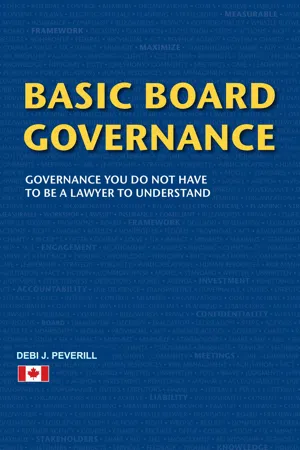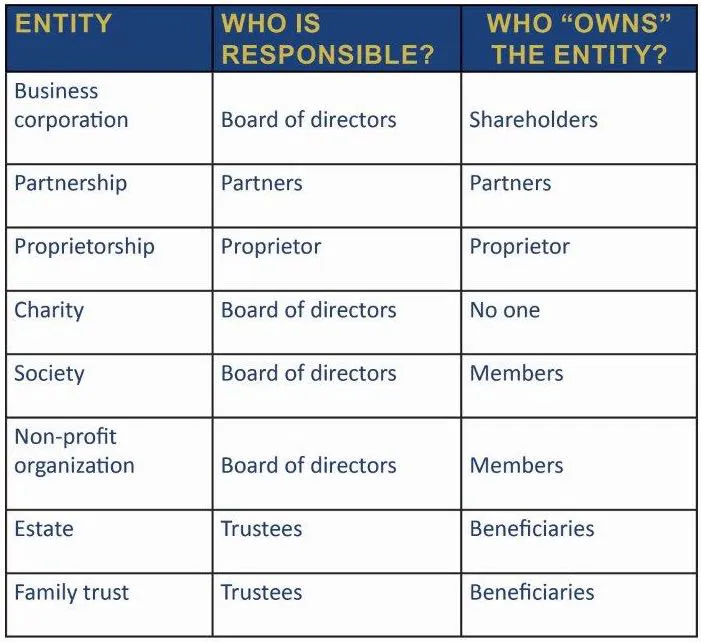
eBook - ePub
Basic Board Governance
Debi J Peverill
This is a test
- English
- ePUB (mobile friendly)
- Available on iOS & Android
eBook - ePub
Basic Board Governance
Debi J Peverill
Book details
Book preview
Table of contents
Citations
About This Book
This book is over 240 pages of practical information and advice written specifically for Canadian directors and board members.
-
Thisbookhas informationfor both non-profit and businesses.
-
Debi has been writing, speaking and consulting about governance forever.
Frequently asked questions
How do I cancel my subscription?
Can/how do I download books?
At the moment all of our mobile-responsive ePub books are available to download via the app. Most of our PDFs are also available to download and we're working on making the final remaining ones downloadable now. Learn more here.
What is the difference between the pricing plans?
Both plans give you full access to the library and all of Perlego’s features. The only differences are the price and subscription period: With the annual plan you’ll save around 30% compared to 12 months on the monthly plan.
What is Perlego?
We are an online textbook subscription service, where you can get access to an entire online library for less than the price of a single book per month. With over 1 million books across 1000+ topics, we’ve got you covered! Learn more here.
Do you support text-to-speech?
Look out for the read-aloud symbol on your next book to see if you can listen to it. The read-aloud tool reads text aloud for you, highlighting the text as it is being read. You can pause it, speed it up and slow it down. Learn more here.
Is Basic Board Governance an online PDF/ePUB?
Yes, you can access Basic Board Governance by Debi J Peverill in PDF and/or ePUB format, as well as other popular books in Betriebswirtschaft & Unternehmensführung. We have over one million books available in our catalogue for you to explore.
Information
Chapter 1. What is Governance and Why Do You Care?
Every person is responsible for his or her own actions. We all know that if we do something wrong that we will suffer the consequences. You are involved in governance all of the time, you just may not have thought of it that way. When you follow the rules—you are being governed. When you make the rules you are governing.
Governance often comes up when we talk about groups such as corporations and societies, but governance is everywhere. It is not just applicable to groups. Throughout this book we are going to use the term organization to refer to corporations, societies, trusts, charities, partnerships, proprietorships, and estates.
Governance is defined as the process used to direct and manage the operations of an organization. You see that this organization could be a business, a non-profit organization (NPO), a charity, a club, or a family.
Organizations are not real people (with the exception of partnerships and proprietorships), so a real person must be responsible for the actions of an organization. That real person is generally called a director. It is very important to understand that only directors are responsible; not members, not shareholders, and not donors. So the decision to become a director is not one to be taken lightly.
Since there must be a real person who is responsible for the activities of every entity, these responsible people need to have a plan to reduce their risk of being sued or held financially liable. So governance is the process used to direct and manage the operations of an organization to reduce risk.
Governance works a little differently depending on the kind of organization we are talking about.
Table 1 illustrates who owns each type of organization and who is responsible. This is a handy way for you to think about the differences between ownership and accountability.
Table 1. Responsibility and “ownership” for organizations

Businesses
If a business is not incorporated, it is known as a proprietorship or a partnership. The owners of this business are the ones who are responsible for that business's activities. There is no separation of liability when a business is not incorporated; the business is the same legal entity as the owner. Governance is still very impor...
Table of contents
- Cover
- Contents
- Copyright
- WHY I WROTE THIS BOOK
- Chapter 1. What is Governance and Why Do You Care? Every
- Chapter 2. An Introduction to Boards Organizations
- Chapter 3. Stakeholders—Who Are These People
- Chapter 4. What Could Go Wrong? Directors’ Liabilities
- Chapter 5. Framework of Board of Directors’ Obligations
- Chapter 6. Duty of Care and Loyalty
- Chapter 7. Duty of Knowledge
- Chapter 8. Duty of Skill
- Chapter 9. Fiduciary Duty
- Chapter 10. Duty to Manage
- Chapter 11. Duty to Act in Scope of Authority
- Chapter 12. Directors’ Rights
- Chapter 13. Individual Board Members—What Should You
- Chapter 14. Reduce Your Risk—Understand Financial Statements
- Chapter 15. Generally Accepted Accounting Principles
- Chapter 16. Generally Accepted Accounting Principles
- Chapter 17. Spread the Blame—Rely on Professionals
- Chapter 18. Internal Control
- Chapter 19. Goods and Services Tax Issues
- Chapter 20. Budgets
- Chapter 21. Income Tax Filing Issues
- Chapter 22. Ten Steps to Reviewing a Set of Financial
- Chapter 23. Personal Guarantees and Insurance
- Chapter 24. Strategic Planning
- Chapter 25. Why Does Your Organization Exist
- Chapter 26. Strategic Plan Template
- Chapter 27. Successful Goal-Keeping System
- Chapter 28. Succession Planning
- Chapter 29. Key Metrics
- Chapter 30. Policy (or Governance) Manual in General
- Chapter 31. Running an Effective Board Meeting
- Chapter 32. Privacy Policies
- Chapter 33. Social Media Policy Considerations
- Chapter 34. Board Evaluation
- Chapter 35. Investment Policy
- Chapter 36. Term Limits
- Chapter 37. Conflicts of Interest
- Chapter 38. Financial Policy—Corporate Tax Filing A
- Chapter 39. Financial Policy—Purchasing
- Chapter 40. Financial Policy—Cash Controls
- Chapter 41. Financial Policy—Cheque Signing
- Chapter 42. Financial Policy—Capital Assets
Citation styles for Basic Board Governance
APA 6 Citation
Peverill, D. (2018). Basic Board Governance (1st ed.). Painless Financial Training Group Inc. Retrieved from https://www.perlego.com/book/2892711/basic-board-governance-pdf (Original work published 2018)
Chicago Citation
Peverill, Debi. (2018) 2018. Basic Board Governance. 1st ed. Painless Financial Training Group Inc. https://www.perlego.com/book/2892711/basic-board-governance-pdf.
Harvard Citation
Peverill, D. (2018) Basic Board Governance. 1st edn. Painless Financial Training Group Inc. Available at: https://www.perlego.com/book/2892711/basic-board-governance-pdf (Accessed: 15 October 2022).
MLA 7 Citation
Peverill, Debi. Basic Board Governance. 1st ed. Painless Financial Training Group Inc., 2018. Web. 15 Oct. 2022.